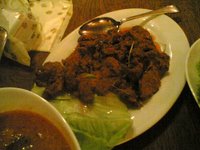I’m a big fan of pork, so you can imagine my excitement when I found out that effective from 9 January, 2007, Old China Cafe was turning non-halal. A number of new dishes had been introduced, all of which contained pork. From babi pong teh (pork belly and pork rump stewed in brown paste sauce with shallots, garlic, mushrooms and potatoes) to sek bak (sliced stewed pork in dark sauce of aromatic spices and malay herbs) to honeyed pork ribs…all glorious sounding pork dishes. The timing is appropriate though, to welcome the Year of the Pig. (Note: Said pig may not be too excited about all the fuss about pork. Oink.)
I’ve always loved Portuguese Devil Curry, a wickedly hot (hence, its name) chicken curry cooked with potatoes, dried chillies, fresh chillies, mustard seeds, vinegar, mustard powder, ginger, garlic and onions. My friend, Molly, once came to my house and gave me a demonstration (how cool is that!) on how to cook this extremely spicy curry, after which we adjourned to the patio to enjoy a lovely eurasian dinner. It’s been a while since I cooked it and it’s been too long since I enjoyed a good devil curry. So when I saw Siew Yoke (roasted pork) Devil Curry listed on the menu, I could hear it calling out my name. Siew Yoke is quite an unusual ingredient in a devil curry, but we’re progressive girls (*smile*) and we’re always game to try something new. However, at RM22.80 a dish, we thought that the portion was rather small and was barely enough for the three of us. Our verdict? The distinctive taste of siew yoke was a little too powerful for the curry and didn’t quite blend in. In addition, the curry wasn’t spicy enough. It ought to be called Devil (L licence-paid off the instructor) Curry instead.
The other pork dish we ordered was Babi Masak Asam (pork cooked in tamarind gravy). We loved the thick, gooey gravy made of bean paste, chillies and daun limau purut (kaffir lime leaves). At RM12.80, it was definitely worth every cent.
We’ve narrowed down our favourite dishes at Old China Cafe to two so far. In addition to Babi Masak Asam, we also like the ayam pong teh, a slightly sweet dish of chicken and bean paste in a black sauce. We didn’t order the ayam pong teh this time as we wanted to concentrate on the new dishes. We finished the meal with a serving of kangkung belacan, which despite sounding extremely ordinary, tasted extraordinary.
Bouncing Barbie and I had sago gula melaka (sago pudding with palm sugar and coconut milk) for dessert while Pretty Pui ordered the bubur pulut hitam (black glutinous rice porridge). The sago gula melaka is DIY, and we liberally loaded up on the dark syrup and coconut milk. Eat first, suffer later! Pretty Pui liked the bubur pulut hitam, but said that it was not as good as the pulut hitam which she had tried in Hong Kong several years back. I thought it lacked enough glutinous rice and santan.
While we ate, the same old chinese music was playing in the background. As always, I was transported back to the olden days in my imaginary world of babas and nyonyas, stained glass, wrapped feet and slim cigarettes.

.jpg)
.jpg)
.jpg)
.jpg)
.jpg)




